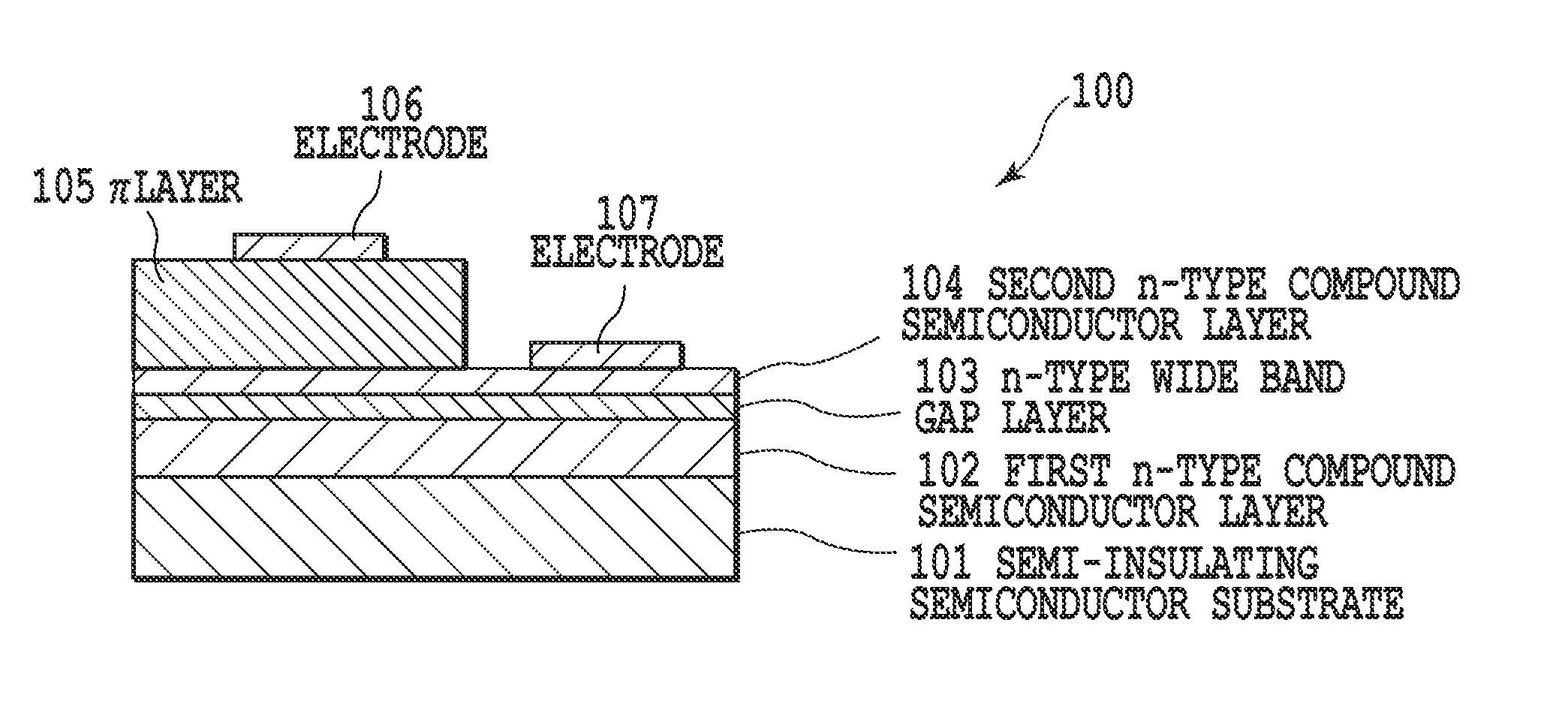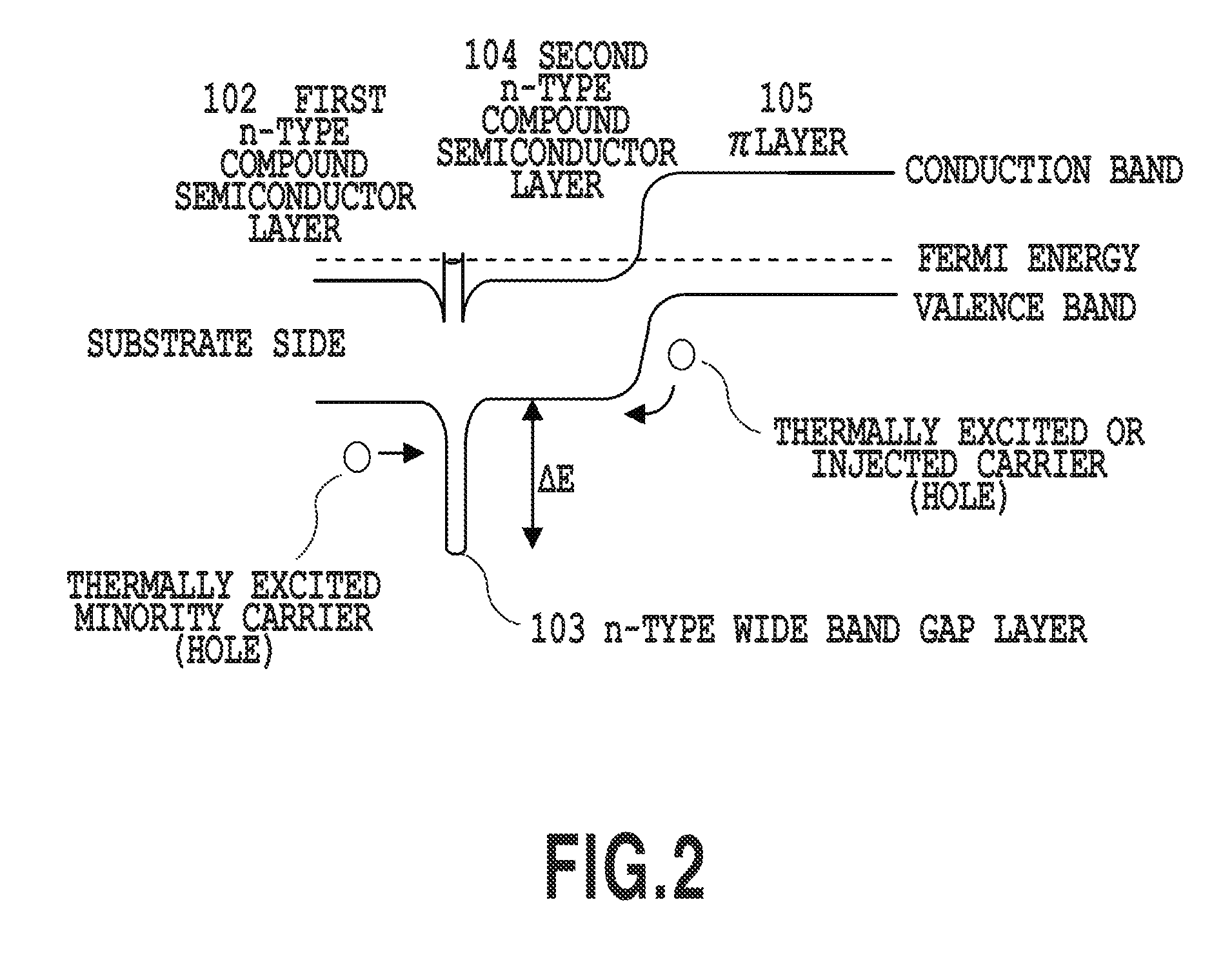Infrared light emitting device
a light-emitting device and infrared light technology, which is applied in the manufacture of semiconductor/solid-state devices, semiconductor devices, electrical equipment, etc., can solve the problems of reducing the sensitivity of gas sensors, reducing the intensity of infrared light, and high filter price, so as to reduce the diffusion current of pn diodes and high diode resistance. , the effect of reducing the dark current of the pn diodes
- Summary
- Abstract
- Description
- Claims
- Application Information
AI Technical Summary
Benefits of technology
Problems solved by technology
Method used
Image
Examples
embodiment 1
[0046]FIG. 1 is a schematic diagram of an infrared light emitting device according to embodiment 1. An infrared light emitting device 100 includes a semi-insulating semiconductor substrate 101; a first n-type compound semiconductor layer 102 on the semiconductor substrate 101; an n-type wide band gap layer 103 on the first n-type compound semiconductor layer 102; a second n-type compound semiconductor layer 104 on the n-type wide band gap layer 103, the second n-type compound semiconductor layer 104 having the same composition as the first n-type compound semiconductor layer 102; a p-type doped π layer 105 on the second n-type compound semiconductor layer 104; an electrode 106 on the π layer 105; and an electrode 107 on the second n-type compound semiconductor layer 104.
[0047]The infrared light emitting device 100 is a so-called PN junction diode, where a depletion layer is formed between the second n-type compound semiconductor layer 104 and the π layer 105. The infrared light emit...
embodiment 2
[0074]FIG. 6 shows an infrared light emitting device 600 according to embodiment 2. The structure from the semiconductor substrate 101 to the π layer 105 is the same as that of embodiment 1, and similar modifications are conceivable. The infrared light emitting device 600 further includes a p-type compound semiconductor layer 601 which is disposed on the n layer 105, is more heavily p-type doped than the π layer 105, and has the same composition as the first n-type compound semiconductor layer or the π layer. This structure is a so-called PIN diode structure.
[0075]Since the p-type compound semiconductor layer 601 is more heavily p-type doped than the π layer 105, electrons injected from n-type doped layers (101 to 104) side can be more efficiently trapped in the π layer than the example of embodiment 1. As a result, recombination emission efficiency of carriers can be enhanced. Furthermore, the heavy p-type doping can lower contact resistance with an electrode 106. The p-type doping...
embodiment 3
[0076]FIG. 7 shows an infrared light emitting device 700 according to embodiment 3. The structure from the semiconductor substrate 101 to the π layer 105 is the same as that of embodiment 1, and similar modifications are conceivable. The infrared light emitting device 700 further includes a p-type wide band gap layer 701 which is disposed directly on the π layer 105, is more heavily p-type doped than the π layer 105, and has a larger band gap than a first n-type compound semiconductor layer 102 and the π layer 105. This structure is also the so-called PIN diode structure.
[0077]FIG. 8 is a schematic diagram of the energy band gap in the infrared light emitting device according to embodiment 3. By making the band gap of the p-type wide band gap layer 701 to be larger than those of the first n-type compound semiconductor layer 102 and the π layer 105, generation of electrons as minority carriers by thermal excitation in the p-type wide band gap layer 701 can be effectively suppressed. ...
PUM
 Login to View More
Login to View More Abstract
Description
Claims
Application Information
 Login to View More
Login to View More - R&D
- Intellectual Property
- Life Sciences
- Materials
- Tech Scout
- Unparalleled Data Quality
- Higher Quality Content
- 60% Fewer Hallucinations
Browse by: Latest US Patents, China's latest patents, Technical Efficacy Thesaurus, Application Domain, Technology Topic, Popular Technical Reports.
© 2025 PatSnap. All rights reserved.Legal|Privacy policy|Modern Slavery Act Transparency Statement|Sitemap|About US| Contact US: help@patsnap.com



